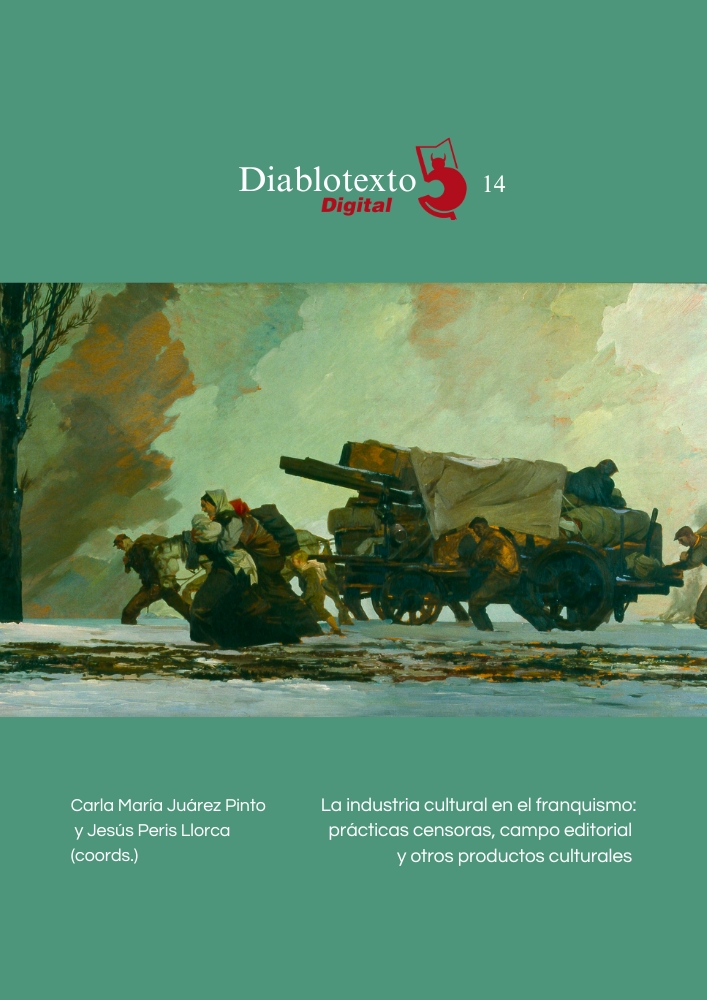Postmemory and Portraiture. The Role of Photography of Children in the Reconstruction of Identity in Postwar Spanish Poetry: Antonio Martínez Sarrión, María Victoria Atencia and Guadalupe Grande
DOI:
https://doi.org/10.7203/diablotexto.14.26490Keywords:
postmemory, identity, civil war, trauma, children's photography, affiliative memory Abstract
Abstract
This article focuses on the analysis of postwar poetic compositions —Antonio Martínez Sarrión, María Victoria Atencia and Guadalupe Grande— that use photographs of children as a starting point for the reconstruction of family history and individual identity. To this end, the concept of post-memory is adopted, as coined by Marianne Hirsh (1992), highlighting three fundamental aspects: the idea of family breakup and the repercussions of trauma on the children of victims; the observation of photographs as spatial and temporal displacement; and the identification not only intergenerational (vertical), but also intragenerational (horizontal), which gives rise to a projective or affiliative memory.
 Downloads
Downloads
 References
References
Alonso Riveiro, Mónica (2016). “La intimidad invisible. Fotografía e infancia en la guerra civil española”, Fotocinema. Revista científica de cine y fotografía, n.° 13, pp. 31-55. Disponible en: http://www.revistafotocinema.com/ [Fecha de consulta: 5 de marzo de 2023].
Ansón, Antonio (coord.) (2002). “Foto & Poesía”, Riff Raff, n.° 19, s.p.
Atencia, María Victoria [1985] (1997). A orillas del Ems, Monográfico “El Vuelo”, Litoral, n.° 213-214, pp. IV-XXXII.
Cano Ballesta, Juan (ed.) [2001] (2002). Poesía española reciente (1980-2000). Madrid: Cátedra.
Ema Llorente, María (2015). “A orillas del Ems, de María Victoria Atencia: una biografía propia con imágenes ajenas”, Revista Internacional de Humanidades, n.° 4 (1), pp. 99-112.
Ema Llorente, María (2014). “Poesía y fotografía. El álbum de familia y su relato”. En La voz de la imagen. Pintura, arquitectura y fotografía en la poesía española contemporánea. México: Afínita, pp. 175-265.
Grande, Guadalupe (2022). Jarrón y tempestad. Segovia: La uña rota.
Grande, Guadalupe (2006). “Mis poemas provienen de un saqueo”, El Ciervo, 55, n.° 661, pp. 247-249.
Grande, Guadalupe (2003). La Llave De Niebla. Madrid: Calambur.
Grande, Guadalupe (1996). El libro de Lilit. Sevilla: Renacimiento.
Grande, Guadalupe (s.a.). “Caja de luz”. Blog de la autora. Disponible en http://guadalupegrande.blogspot.com/ [Fecha de consulta: 23 de marzo de 2023].
Grande, Guadalupe (s. a.). “Jarrón y tempestad”. Disponible en http://guadalupegrande.blogspot.com/p/videopoemas.html [Fecha de consulta: 3 de Septiembre de 2022].
Hirsch, Marianne [2012] (2015). La generación de la posmemoria. Madrid: Carpe Noctem.
Hirsch, Marianne (1997). Family Frames: Photography, Narrative, and Postmemory. Cambridge y Londres: Harvard University Press.
Hirsch, Marianne (1992). “Family pictures: Maus, Mourning and Post-Memory”, Discourse: Journal for Theoretical Studies in Media and Culture, vol. 15, n.° 2, pp. 3-29.
Insausti, Gabriel (2004). Destiempo. Sevilla: Renacimiento.
Jelin, Elizabeth (2012). “Militantes y combatientes en la historia de las memorias: silencios, denuncias y reivindicaciones”. En A. Huffschmid y V. Durán (eds.), Topografías conflictivas: memorias, espacios y ciudades en disputa. Buenos Aires: Nueva Trilce, pp. 70-83.
Jurado Morales, José (2021). Soldados y padres. De guerra, memoria y poesía. Sevilla: Fundación José Manuel Lara.
Kruchen, Renate (ed.) (1983). Telgte in Erinnerung. Für Bewohner und Freunde einer kleinen Stadt. Harsewinkel: Rhode.
Lafarque, Antonio; Mesa Toré, José Antonio (eds.) (2010). “Escribir la luz. Fotografía y Literatura”, Litoral, n.º 250, s.p.
López Vilar, Marta (ed.) (2016). (Tras)lúcidas. Poesía escrita por mujeres (1980-2016). Madrid: Bartleby Editores.
Martínez Sarrión, Antonio (1999). Cordura. Madrid: Tusquets.
Mesa Toré, José Antonio (1998). La primavera nórdica. Valencia: Pre-textos.
O’Donoghue, Samuel (2019). “Posmemoria y trauma: algunos problemas teóricos y sus consecuencias para la crítica literaria”, Pasajes, n.º 56, pp. 8-25.
Quílez Esteve, Laia (2014). “Hacia una teoría de la posmemoria. Reflexiones en torno a las representaciones de la memoria generacional”, Historiografías, n.° 8, pp. 57-75.
Sarlo, Beatriz (2005). “Postmemoria, reconstrucciones”. En Tiempo pasado: cultura de la memoria y giro subjetivo. Una discusión. Buenos Aires: Siglo XXI.
Silverman, Kaja (1996). The Threshold of the Visible World. New York: Routledge.
Triquell, Agustina (2012). Fotografías e historias. La construcción narrativa de la memoria y las identidades en el álbum fotográfico familiar. Montevideo: Glenur.
Ugalde, Sharon Keefe (ed.) (1991). Conversaciones y poemas. La nueva poesía femenina española en castellano. Madrid: Siglo XXI.
Violi, Patrizia (2020). “Los engaños de la posmemoria”, Tópicos del Seminario, Semiótica y posmemoria I, n.° 44, pp. 12-28.
Downloads
Published
How to Cite
-
Abstract193
-
PDF (Español)66
Issue
Section
License
Authors who publish with this journal agree to the following items:
The authors will keep their copyright and guarantee the journal the right of first publication of their work, which will be simultaneously subject to the Creative Commons license that allows third parties to share the work indicating its author and its first publication in the journal. The authors may adopt other non-exclusive license agreements to distribute the version of the published work (e.g., depositing it in an institutional telematic file or publishing it in a monographic volume), with an acknowledgment of its initial publication in this journal. The authors are allowed and encouraged to disseminate their work through the Internet (e.g., in institutional telematic archives or on their website) before and during the submission process, which can produce interesting exchanges and increase citations of the published work. (See Effect of Open Access)



